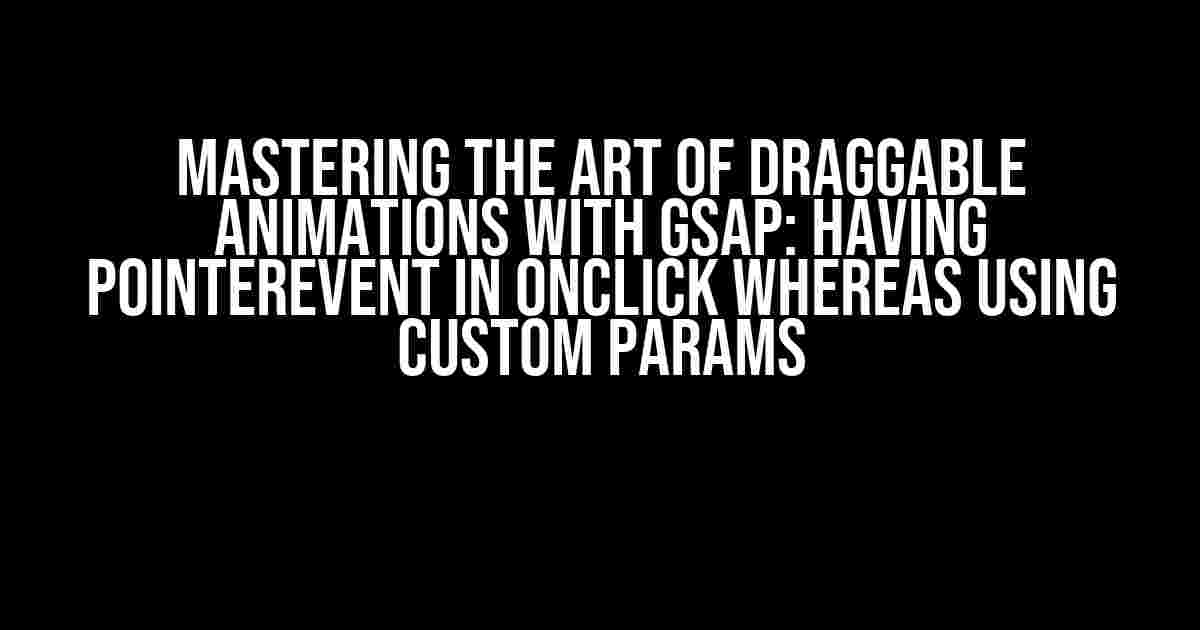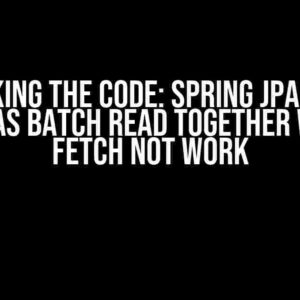Are you tired of creating boring, static animations? Do you want to take your web development skills to the next level by creating interactive and engaging experiences? Look no further! In this article, we’ll dive into the world of GSAP’s Draggable plugin and explore the magic of using custom parameters with pointerEvent in onClick events. Buckle up, folks, and get ready to unleash your creativity!
What is GSAP and the Draggable Plugin?
GSAP (GreenSock Animation Platform) is a powerful JavaScript library that enables you to create stunning animations and interactions with ease. One of its most popular plugins is Draggable, which allows you to create drag-and-drop interactions, scrolling effects, and much more.
With the Draggable plugin, you can turn any DOM element into a draggable object, adding a new level of interactivity to your web applications. But, have you ever wondered how to take it to the next level by using custom parameters and pointerEvent in onClick events? That’s what we’re about to explore!
The Power of Custom Parameters
In GSAP, custom parameters are a game-changer when it comes to creating complex animations and interactions. By passing custom data to your animations, you can create unique and dynamic effects that respond to user input, scrolling, or even gestures.
gsap.to("#myElement", {
duration: 2,
x: 100,
y: 200,
// custom parameter: "myData"
myData: {
prop1: "value1",
prop2: "value2"
}
});In the example above, we’re creating a simple animation that moves an element 100 pixels to the right and 200 pixels down. But, we’re also passing a custom parameter called “myData” with two properties: “prop1” and “prop2”. This data can be accessed within the animation and used to create dynamic effects.
PointerEvent in onClick Events
Now, let’s talk about pointerEvent in onClick events. When a user interacts with a draggable element, GSAP captures the event and provides it to the onClick callback function. This allows you to access information about the event, such as the position of the pointer, the target element, and more.
Draggable.create("#myElement", {
onClick: function(event) {
console.log(event.pointerEvent.clientX);
console.log(event.pointerEvent.clientY);
}
});In the example above, we’re creating a draggable element with an onClick callback function. Within this function, we can access the pointerEvent object, which contains information about the event, such as the clientX and clientY coordinates.
Combining Custom Parameters and PointerEvent
So, how do we combine custom parameters with pointerEvent in onClick events? It’s actually quite simple! Let’s take a look at an example:
Draggable.create("#myElement", {
onClick: function(event, params) {
console.log(params.myData.prop1);
console.log(event.pointerEvent.clientX);
},
params: {
myData: {
prop1: "value1",
prop2: "value2"
}
}
});In this example, we’re creating a draggable element with an onClick callback function and custom parameters. Within the callback function, we can access both the custom parameter “myData” and the pointerEvent object.
Real-World Applications
So, what are some real-world applications of using custom parameters and pointerEvent in onClick events? Here are a few ideas:
- Drag-and-drop interactions: Create a drag-and-drop interface where users can drag items onto a target area. Use custom parameters to store information about the dragged item, and access the pointerEvent to determine the drop location.
- Interactive simulations: Create an interactive simulation where users can manipulate objects on the screen. Use custom parameters to store information about the object’s state, and access the pointerEvent to determine the user’s input.
- Game development: Create a game where users can interact with game objects. Use custom parameters to store information about the game object’s state, and access the pointerEvent to determine the user’s input.
Tips and Tricks
Here are some additional tips and tricks to keep in mind when using custom parameters and pointerEvent in onClick events:
| TIP | DESCRIPTION |
|---|---|
| Use meaningful parameter names | Choose parameter names that are easy to understand and remember, making it easier to access and use the data. |
| Keep your parameters organized | Use objects or arrays to organize your custom parameters, making it easier to access and manipulate the data. |
| Use pointerEvent wisely | Be mindful of the pointerEvent’s limitations and potential issues, such as touch events or multiple pointers. |
| Test and debug thoroughly | Make sure to test your animations and interactions thoroughly, debugging any issues that arise. |
Conclusion
In this article, we’ve explored the powerful combination of custom parameters and pointerEvent in onClick events using GSAP’s Draggable plugin. By mastering this technique, you’ll be able to create complex and engaging animations and interactions that take your web development skills to the next level.
Remember to keep your custom parameters organized, use meaningful names, and access the pointerEvent wisely. With practice and patience, you’ll be creating stunning animations and interactions in no time!
So, what are you waiting for? Get creative and start building your next project with GSAP and the Draggable plugin. Happy coding!
Frequently Asked Question
Get ready to unleash the power of GreenSock’s Draggable plugin with custom params and pointerEvent in onClick, and clarify any doubts you may have with these frequently asked questions!
What is the purpose of using pointerEvent in onClick when working with custom params in GSAP’s Draggable plugin?
When using GSAP’s Draggable plugin, specifying pointerEvent in onClick allows you to capture the original event that triggered the click, giving you access to the event’s properties and enabling more precise control over the animation. This is especially useful when working with custom params, as you can utilize the event data to customize the animation’s behavior.
Can I use custom params in GSAP’s Draggable plugin without specifying pointerEvent in onClick?
Yes, you can use custom params in GSAP’s Draggable plugin without specifying pointerEvent in onClick. However, keep in mind that you won’t have access to the original event that triggered the click, which might limit the level of control you have over the animation. If you need to utilize event data to customize the animation, it’s recommended to use pointerEvent in onClick.
How do I pass custom params to the onComplete callback when using GSAP’s Draggable plugin with pointerEvent in onClick?
To pass custom params to the onComplete callback, you can utilize the params object in the Draggable instance. For example, you can set params: { onComplete: yourCallbackFunction, onCompleteParams: [yourCustomParam1, yourCustomParam2] }. Then, in your callback function, you can access the custom params using the arguments array, such as arguments[0] for yourCustomParam1 and arguments[1] for yourCustomParam2.
Will using pointerEvent in onClick impact the performance of my animation when using GSAP’s Draggable plugin?
The impact of using pointerEvent in onClick on performance is generally minimal, as it only involves capturing the original event and storing it in the Draggable instance. However, if you’re working with a large number of elements or complex animations, it’s essential to optimize your code and ensure that you’re not creating excessive event listeners or redundant function calls.
What are some common use cases for using custom params with pointerEvent in onClick in GSAP’s Draggable plugin?
Common use cases for using custom params with pointerEvent in onClick include tracking user interactions, such as click coordinates or swipe direction, to influence the animation’s behavior. You might also use custom params to toggle animation states, adjust animation timing, or even trigger additional animations based on user input.



